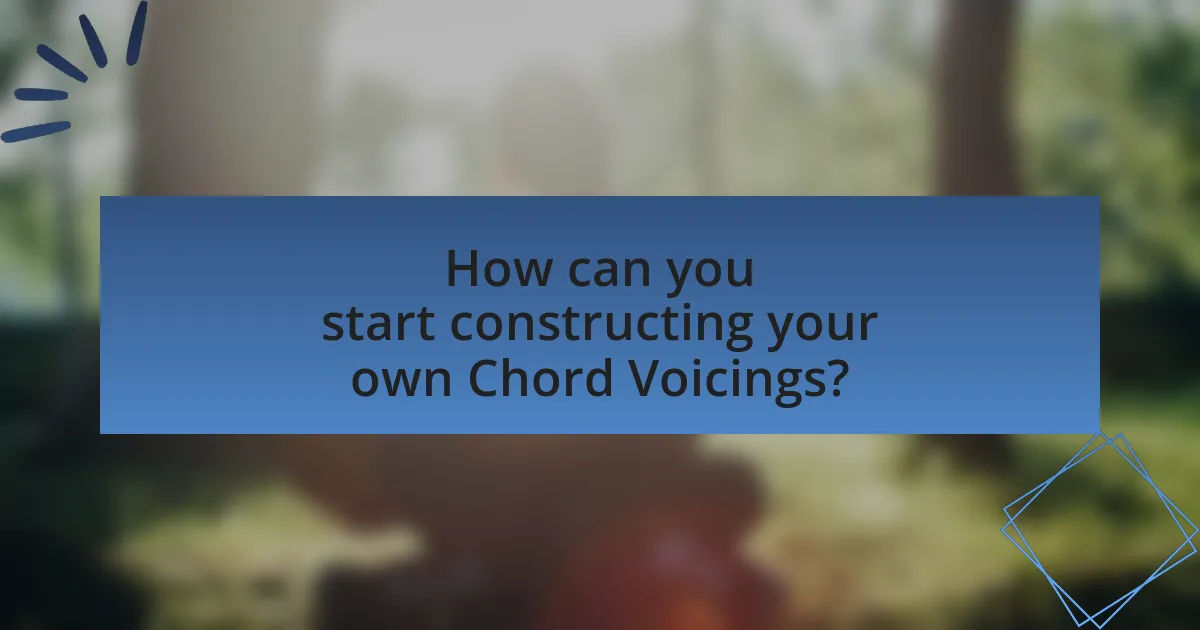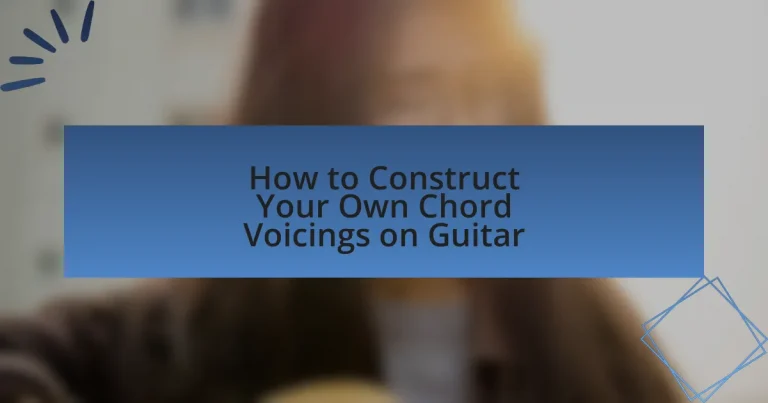Chord voicings in guitar refer to the specific arrangement of notes within a chord, influencing how it is played and perceived. This article explores the differences between chord voicings and standard chords, highlighting their importance for guitarists in creating unique sounds and enhancing musical expression. Key components of chord voicings, such as intervals and finger positioning, are discussed, along with practical steps for constructing personalized voicings. Additionally, advanced techniques, common mistakes, and resources for mastering chord voicings are provided, making it a comprehensive guide for musicians seeking to develop their own style.

What are Chord Voicings in Guitar?
Chord voicings in guitar refer to the specific arrangement of notes within a chord, determining how the chord is played and perceived. Each voicing can emphasize different notes, creating unique sounds and textures, which can significantly alter the emotional impact of the music. For example, a C major chord can be voiced in various ways, such as playing the notes in different octaves or using alternative fingerings, which can enhance the harmonic richness. This concept is essential for guitarists seeking to create their own chord progressions and develop a distinctive musical style.
How do Chord Voicings differ from Standard Chords?
Chord voicings differ from standard chords primarily in their arrangement of notes. While standard chords typically consist of the root, third, and fifth notes stacked in thirds, chord voicings can rearrange these notes or include additional tones, such as sevenths or ninths, to create different textures and colors. For example, a C major chord in standard form includes the notes C, E, and G, whereas a Cmaj7 voicing might include C, E, G, and B, altering the harmonic quality. This flexibility allows musicians to express a wider range of emotions and styles in their playing.
What are the characteristics of different Chord Voicings?
Different chord voicings are characterized by their unique arrangements of notes, which can alter the harmonic texture and emotional quality of music. For instance, open voicings, which spread the notes of a chord across a wider range, create a more resonant and airy sound, while closed voicings, where notes are stacked closely together, produce a denser and more compact sound. Additionally, extended voicings incorporate additional tones beyond the basic triad, such as seventh or ninth chords, adding complexity and richness to the harmony. Altered voicings, which modify specific notes (like raising or lowering certain intervals), can introduce tension and dissonance, enhancing the expressiveness of a piece. These characteristics are essential for musicians to understand when constructing their own chord voicings on guitar, as they directly influence the overall sound and feel of the music.
Why are Chord Voicings important for guitarists?
Chord voicings are important for guitarists because they provide a variety of ways to play the same chord, enhancing musical expression and creativity. By using different voicings, guitarists can create unique sounds and textures, allowing for more dynamic arrangements and compositions. For example, jazz guitarists often utilize extended and altered chord voicings to add complexity and richness to their playing, which can significantly impact the overall feel of a piece. This versatility in chord voicings enables guitarists to adapt to various musical styles and genres, making it a crucial skill for effective performance and songwriting.
What are the basic components of Chord Voicings?
The basic components of chord voicings are the root, third, and fifth of the chord, along with additional extensions such as the seventh, ninth, eleventh, and thirteenth. The root establishes the chord’s identity, while the third determines whether the chord is major or minor. The fifth adds stability, and extensions provide color and complexity to the sound. These components can be arranged in various ways to create different voicings, allowing for a wide range of harmonic possibilities on the guitar.
How do intervals play a role in Chord Voicings?
Intervals are fundamental in determining chord voicings, as they define the distance between notes and shape the harmonic structure of chords. In chord voicings, different intervals create unique textures and colors; for example, a major third interval gives a bright sound, while a minor third creates a more somber tone. The specific arrangement of intervals within a voicing influences the overall character of the chord, allowing musicians to convey different emotions and styles. Additionally, the choice of intervals can affect the voice leading in progressions, making transitions between chords smoother or more complex. This relationship between intervals and chord voicings is essential for effective musical expression and composition.
What is the significance of finger positioning in Chord Voicings?
Finger positioning in chord voicings is significant because it directly affects the sound quality, playability, and harmonic richness of the chords played on the guitar. Proper finger placement allows for clearer notes, smoother transitions between chords, and the ability to access a wider range of voicings. For example, using different finger positions can create variations in tone and texture, such as open versus barre chords, which can enhance musical expression. Additionally, effective finger positioning can facilitate easier finger movement, reducing strain and improving overall technique, which is essential for both beginners and advanced players.

How can you start constructing your own Chord Voicings?
To start constructing your own chord voicings, begin by understanding the basic chord structures and their intervals. Familiarize yourself with major, minor, diminished, and augmented chords, as well as their extensions like 7ths, 9ths, and 11ths. This foundational knowledge allows you to experiment with different note combinations and finger placements on the guitar.
For example, a C major chord consists of the notes C, E, and G. You can create variations by altering the order of these notes or adding additional tones, such as a B for a Cmaj7 voicing. Exploring different voicings across the fretboard enhances your creativity and helps you discover unique sounds.
Additionally, analyzing existing songs and their chord progressions can provide insight into effective voicing techniques. By practicing these methods, you will develop a personal style and a deeper understanding of harmony in music.
What steps should you follow to create unique Chord Voicings?
To create unique chord voicings, start by exploring different chord shapes and fingerings on the guitar. Experiment with altering the order of notes in a chord, such as playing a C major chord in different inversions (C-E-G, E-G-C, G-C-E). Additionally, incorporate extensions and alterations, like adding the 7th, 9th, or 11th notes to standard chords, which can provide a richer sound.
Utilize open strings in your voicings to create resonance and a fuller tone, as seen in many folk and rock styles. Furthermore, analyze existing songs and their chord progressions to identify unique voicings that resonate with you, allowing you to adapt and personalize them.
Finally, practice regularly to internalize these techniques, as consistent application will lead to the development of your own distinctive style.
How do you choose the root note for your Chord Voicings?
To choose the root note for your chord voicings, identify the key of the song or progression you are working with. The root note serves as the foundation of the chord and is typically the first note of the scale associated with that key. For example, in the key of C major, the root note is C, which allows you to build chords such as C major, D minor, and E minor based on the scale degrees. This method ensures that your chord voicings are harmonically relevant and support the overall tonality of the music.
What techniques can you use to experiment with different voicings?
To experiment with different voicings, musicians can utilize techniques such as transposing chords, altering finger positions, and incorporating extensions or alterations. Transposing chords allows musicians to explore voicings in various keys, enhancing their understanding of harmonic relationships. Altering finger positions, such as using barre chords or open strings, can create unique textures and sounds. Additionally, incorporating extensions like 7ths, 9ths, or altered tones can enrich the harmonic palette, providing a broader range of voicings. These techniques are widely used in guitar playing to develop a personalized sound and improve overall musicianship.
What tools and resources can assist in constructing Chord Voicings?
Chord voicings can be constructed using various tools and resources such as chord charts, music theory books, and software applications like guitar tab editors. Chord charts provide visual representations of finger placements and can help in understanding different voicings. Music theory books, such as “The Complete Guitar Manual” by David Burrows, explain the principles behind chord construction and voicing techniques. Additionally, software applications like Guitar Pro allow users to experiment with different voicings and hear them played back, facilitating a deeper understanding of how voicings sound in context. These resources collectively enhance the ability to create and explore diverse chord voicings on the guitar.
How can chord charts and diagrams help in your learning process?
Chord charts and diagrams significantly enhance the learning process by providing visual representations of finger placements and chord structures. These tools simplify the understanding of complex chord shapes, making it easier for learners to grasp the relationships between notes and how they form chords. Research indicates that visual aids, such as diagrams, improve retention and comprehension in music education, as they cater to visual learning styles. For instance, a study published in the Journal of Music Theory found that students who utilized chord diagrams demonstrated a 30% increase in their ability to recall chord shapes compared to those who relied solely on text-based instructions. Thus, chord charts and diagrams serve as essential resources for effective learning and mastery of guitar chord voicings.
What role do online tutorials and apps play in mastering Chord Voicings?
Online tutorials and apps are essential tools for mastering chord voicings, as they provide structured learning, visual aids, and interactive practice opportunities. These resources often include video demonstrations, chord charts, and exercises that cater to various skill levels, enabling users to understand and apply different voicings effectively. For instance, platforms like YouTube offer countless tutorials that break down complex voicings into manageable steps, while apps such as Ultimate Guitar provide instant access to a vast library of chords and progressions. This accessibility and variety enhance the learning experience, allowing musicians to practice at their own pace and receive immediate feedback, which is crucial for skill development.

What are some advanced techniques for Chord Voicings?
Advanced techniques for chord voicings include the use of extended chords, altered chords, and voice leading. Extended chords, such as 9ths, 11ths, and 13ths, add additional tones to the basic triad, enriching the harmonic texture. Altered chords involve modifying the fifth or ninth of a chord, creating tension that resolves effectively in progressions. Voice leading focuses on the smooth transition between chords by minimizing the movement of individual notes, which enhances the overall flow of the music. These techniques are widely used in jazz and contemporary music to create more complex and interesting harmonic structures.
How can you incorporate jazz elements into your Chord Voicings?
Incorporating jazz elements into your chord voicings can be achieved by using extended chords, altered chords, and incorporating voice leading techniques. Extended chords, such as 7th, 9th, 11th, and 13th chords, add richness and complexity to the harmony, which is a hallmark of jazz music. Altered chords, which include altered extensions like b9, #9, #11, and b13, create tension and resolution, enhancing the jazz feel. Additionally, employing voice leading techniques, where you smoothly connect chords by moving the least amount of notes possible, contributes to a more fluid and sophisticated sound. These methods are supported by jazz theory, which emphasizes the importance of harmonic complexity and smooth transitions in chord progressions.
What are extended chords and how do they enhance your voicings?
Extended chords are chords that include notes beyond the basic triad, typically incorporating the seventh, ninth, eleventh, or thirteenth degrees of the scale. These chords enhance voicings by adding complexity and richness, allowing for more expressive harmonic textures. For example, a Cmaj7 chord includes the notes C, E, G, and B, while a Cmaj9 chord adds D, creating a fuller sound. The use of extended chords can also facilitate smoother voice leading and create more interesting progressions, as they often contain common tones with adjacent chords, making transitions more fluid.
How can you use inversions to create more complex Chord Voicings?
Inversions can be used to create more complex chord voicings by rearranging the order of the notes in a chord, allowing for different bass notes and harmonic textures. For example, a C major chord can be played in root position (C-E-G), first inversion (E-G-C), or second inversion (G-C-E), each providing a distinct sound and feel. This technique enhances the harmonic richness and can facilitate smoother transitions between chords, as certain inversions may share common tones with adjacent chords. By utilizing inversions, guitarists can explore a wider range of voicings, making their playing more dynamic and expressive.
What are common mistakes to avoid when creating Chord Voicings?
Common mistakes to avoid when creating chord voicings include neglecting voice leading, overcomplicating chords, and ignoring the context of the music. Neglecting voice leading can result in disjointed transitions between chords, which disrupts the flow of the music. Overcomplicating chords by adding unnecessary extensions can make them difficult to play and less effective in conveying the intended emotion. Ignoring the context of the music, such as the genre or the specific song structure, can lead to voicings that do not fit well within the overall composition. These mistakes can hinder the effectiveness and playability of the chord voicings.
How can improper finger placement affect your sound?
Improper finger placement can significantly degrade the quality of sound produced on the guitar. When fingers are not positioned correctly on the fretboard, they can mute adjacent strings or fail to press down on the intended string firmly enough, resulting in a weak or unclear note. This is particularly critical in chord voicings, where precise finger placement is essential for achieving the desired harmony and resonance. Studies in music pedagogy indicate that correct finger positioning enhances both the clarity and sustain of notes, while improper placement can lead to dissonance and a lack of tonal richness.
What should you watch out for when experimenting with voicings?
When experimenting with voicings, musicians should watch out for dissonance that can disrupt the harmonic flow of a piece. Dissonance occurs when certain notes clash, creating tension that may not be suitable for the musical context. For example, using a voicing that includes both a major seventh and a minor third can lead to an unresolved sound that may not fit well within a progression. Additionally, musicians should be mindful of voice leading, ensuring that the movement between chords is smooth and logical, as abrupt changes can create jarring transitions.
What practical tips can help you master Chord Voicings?
To master chord voicings, practice regularly by experimenting with different finger placements and inversions. Regular practice allows you to discover unique sounds and improve your familiarity with the fretboard. Additionally, analyze songs you enjoy to understand their chord structures and voicings, which can provide insights into effective voicing techniques. Using a metronome can help you maintain timing while transitioning between voicings, reinforcing your rhythm skills. Lastly, recording your practice sessions can help you identify areas for improvement and track your progress over time.
How often should you practice creating new Chord Voicings?
To effectively develop new chord voicings, practice should occur daily. Consistent daily practice allows musicians to explore various voicings, enhancing their understanding of harmony and finger positioning. Research indicates that regular, focused practice leads to improved skill acquisition and retention, as evidenced by studies on motor learning and musical proficiency. Therefore, daily engagement in creating new chord voicings is essential for mastery in this area.
What exercises can improve your understanding of Chord Voicings?
To improve your understanding of chord voicings, practice exercises such as playing different inversions of chords across the fretboard. This exercise helps familiarize you with the various positions and sounds of each chord. Additionally, transcribing and analyzing songs that utilize unique chord voicings enhances your ability to recognize and implement them in your playing. Research indicates that actively engaging with diverse chord structures leads to a deeper comprehension of harmonic relationships, which is essential for constructing your own voicings effectively.


